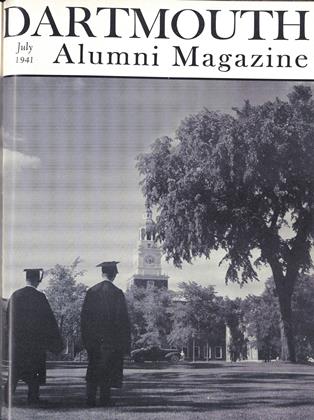No ONE EVER devoted himself more enthusiastically to the search for greater scientific knowledge than did Dr. Francis Hobart Herrick, Dartmouth '81, who died September 12th at the age of 81 in his home in Cleveland.
Dr. Herrick was, first of all, a teacher.
He founded the Department of Biology at Western Reserve University in Cleveland in 1888. He taught there for 40 years, retiring as professor emeritus of biology in 1929. The biology laboratory he instituted at Reserve at the beginning of his career was the second of its kind in the country, and he thus was a pioneer in the teaching methods of modern biological science. But notwithstanding his devotion and thorough application to his teaching, he still managed to fill his life with fascinating scientific adventures, in which he explored little known avenues of nature.
It was while he was studying at Johns Hopkins University, after his graduation from Dartmouth, that Dr. Herrick first became interested in the lobster.
Not much was known at the time about the habits and life history of this crustacean. The lobster industry, moreover, was facing possible ruin, for the annual lobster catch was rapidly diminishing. Because of this, Dr. Herrick set out to learn all there was to be known about lobsters.
His findings, after patient, careful research, were published by the U. S. Department of Fisheries in two volumes. The first was "The American Lobster," published in 1895, and the second, which came out in 1911, was "The Natural History of the American Lobster." These works formed the basis for intelligent protection of our lobster industry, and Dr. Herrick was rated the leading world authority on the subject.
But this was only one of several scientific contributions for which he became known outside his profession of teaching. Dr. Herrick grew up with a great love of nature and the outdoors. Particularly, he was fond of birds. As a youth he had plenty of opportunity to indulge this interest, for he was born and raised in the New England hills, at Woodstock, Vt. After he joined the Reserve faculty and made his home in Cleveland, he came back to spend summers at Northfield, N. H. There he became a pioneer in modern bird photography around the turn of the century.
He was the first to use tent blinds in making closeup photographs of birds, showing, in particular, intimate details of their nesting habits and raising of the young. In 1901, he published a book called "The Home Life of the Birds." It was illustrated with 130 bird photographs. This was the forerunner of the many nature books of today that are beautifully illustrated by photography.
His interest in John J. Audubon, the great naturalist, was another of his scientific adventures. Audubon had become almost forgotten by the American people. Dr. Herrick was graduated from Dartmouth and had joined the American Association for the Advancement of Science without ever having heard of him.
So he set out to trace all the source material existing on Audubon.
The trail led to England, France, the Mississippi Valley, New York City, a hundred obscure places where Audubon had been. Finally, Dr. Herrick uncovered papers that told the whole story. In 1917 he published, in two volumes, his well known "Life of Audubon, the Naturalist." Since then, Audubon has become popular with biographers. But Dr. Herrick's distinguished work still is regarded by many as the best. Furthermore, the material he located comprises the basic documents from which all Audubon scholars work.
Dr. Herrick had another interest that gained him renown. He was the greatest authority on the American eagle. In the 1920's he began to make careful observations of an aerie of eagles in the top of a big ash tree on a farm near Vermilion, Ohio. No one ever had made a comprehensive, close-range study of our national bird, and Dr. Herrick resolved to do it.
The result was his book, "The American Eagle, a Study in Natural and Civil History." It was an exhaustive bit of research. Dr. Herrick went to great lengths to learn all any man could know about American eagles; he even built a 90-foot steel tower alongside the nest, so he could look down into it and watch every move the eagles made, through nest building, egg laying, rearing of the young.
But as well known as he was for these scientific ventures, Dr. Herrick cherished most his standing as a teacher. He was one of the most popular professors during his many years on the Reserve faculty. Although almost frail in stature, Dr. Herrick possessed an enthusiasm for his science, and for life in general, that expressed New England ruggedness. He carried much of
"the still North" in his heart. Once he was asked if he would go to Dartmouth if it were to do over again. He replied: "Yes and I should like to relive my life in order to do that."
FACULTY TESTIMONIAL President Hopkins was given a dinner bythe faculty of the College June I in celebration of his 25th anniversary. He is showncutting the handsome cake which wasbaked and decorated by the staff in ThayerHall under the direction of Mrs. ElizabethS. Hayward, manager of the DartmouthDining Association.
37TH ANNUAL MEETING OF DARTMOUTH SECRETARIES ASSOCIATION HELD WEEK END AFTER COMMENCEMENT WHICH THIS YEAR INCLUDED MEETINGS OF CLASS AGENTS AND CLASS TREASURERS.
 View Full Issue
View Full Issue
More From This Issue
-
 Article
ArticleDirectory of Alumni in Service
July 1941 -
 Article
ArticleBaccalaureate Hits Hypocrisy
July 1941 -
 Class Notes
Class NotesFifteenth Reunion of 1926
July 1941 By ROBERT E. CLEARY -
 Class Notes
Class NotesThe Tremendous 20th
July 1941 By CHARLES A. STICKNEY JR. '21 -
 Class Notes
Class NotesSuper Twenty-Fifth of 1916
July 1941 By FLETCHER R. ANDREWS -
 Article
ArticleCommencement Closes 172nd Year
July 1941








